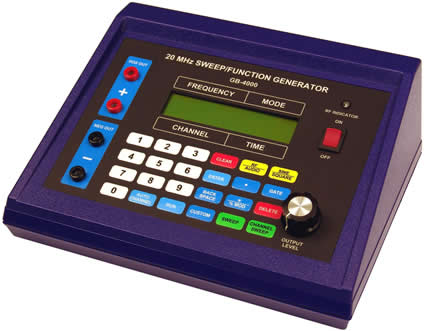The GB-4000 has 2000 programmable channels that hold up to 48 frequencies each.
20 Megahertz Sweep/Function Generator
New 3.1 MHz carrier frequency.
With 1/100th of a Hertz resolution.
The GB-4000 is the only Frequency Generator capable of running 8 frequencies simultaneously

The GB-4000 is capable of outputting all frequencies from 1 to 20 million hertz.
The GB-4000 is also capable of sweeping from 1 to 20 million hertz.
Power and Running Multiple frequencies Some people have asked? Does running multiple frequencies reduce the power level of the frequencies? The answer to that question would be yes, but only if you do not have enough power output. This is why we built the GB-4000 with the ability to output 4.7 watts at 100% duty cycle using an RF (Radio Frequency) carrier frequency. This is about 23.5 to 47 times more power output than the 1957 instrument. Using an RF carrier frequency is the only way the power level could be increased. The original 1957 contact instrument did not use an RF carrier frequency so they could only output one audio frequency at a time with only 0.10 (1/10th) to 0.20 (1/5th) of one watt of power. This power level worked very well with only one audio frequency. In order to overcome this limitation, the GB-4000 uses two separate circuits. The "Audio Mode" circuit has no RF carrier frequency and 0.75-watts power output. It is used for frequencies from 1 Hertz to 400,000 Hertz. Frequencies used with this "Audio Mode" circuit can be physically felt from 1 to about 20,000 Hertz. The "RF Mode" circuit is used for frequencies from 1 Hertz to 20 million Hertz. The 3.1 MHz carrier frequency can also be used with this circuit. Because of the RF carrier, any audio frequencies cannot be felt. Using this method it is possible to use 4.7-watts and makes it possible to run up to 8 frequencies simultaneously with almost 6 time the 1957 power level per frequency. This is why the GB-4000 can run up to 8 frequencies with sufficient power output. Logically when using the 1957 power level if you used 2 audio frequencies using this RF circuit you would want to double that power level (2 X 0.20 = 0.40% of one watt) to 0.40% of one watt. If you run up to 8 audio frequencies you would want at least 8 times that power level or 1.60-watts peak. This is why the GB-4000 has 4.7-watts power output so that it has almost 6 times the power capability needed for running 8 audio frequencies simultaneously at the original 1957 capability. Some people also ask if they can only run multiple frequencies. The answer to that question is no. The GB-4000 gives you the flexibility to switch from running one audio frequency at a time to being able to run up to 8 audio frequencies at a time. You can choose how you want to run the frequencies. Many people want even more power than the GB-4000 power levels per audio frequency. If you want more power then you can purchase the SR-4 1 to15-watt power amplifier and you will have 1.87-watts of power for each frequency if you run 8 audio frequencies simultaneously. If you decide to only run 4 audio frequencies simultaneously then you would have 3.75 watts of power for each frequency. And if you only run one frequency you can have up to 15-watts of power for a single audio frequency. If you want even more power than 15-watts of power then you can purchase the M.O.P.A., gas tube amplifier which is a variable 20 to 190-watts maximum power instrument. With this instrument, you could run up to 8 audio frequencies simultaneously with up to 23.75-watts of power for each audio frequency. We look at it as going from good to better to best. The GB-4000 can output up to 8 frequencies simultaneously up to 40,000 Hertz and 2 frequencies up to 20,000,000 Hertz. Each frequency is generated and output in a pure waveform. With its 20 MHz (20 million Hertz) frequency range it has the ability to generate millions of individual frequencies in pure waveforms which can be put into individual channels and run as sequences of individual or multiple frequencies. Some manufacturers claim that running multiple frequencies simultaneously causes the purity of each individual waveform to be lost as well as creating the possibility of canceling out or creating other frequencies. Rarely are other frequencies created and when they are generally beat frequencies which are considered beneficial. Even though frequencies combined together may seem to lose their individual clarity, all the components of each frequency are present. Think of an orchestra playing many different instruments. Though they combine together to make beautiful music, each instrument’s full sound components are still present and nothing is lost. In order for a frequency to be canceled out, the same frequency must be introduced 180 degrees out of phase. Since the GB-4000 does not output the same frequency 180 degrees out of phase the canceling of a frequency is not possible. The original 1930's/1950's instruments did not have any of these problems and neither do our instruments. Those who run multiple frequencies simultaneously are seeking the benefits of using multiple frequencies. The time-saving benefit is the main reason most people prefer to use multiple frequencies. |
The GB-4000 FREQUENCY GENERATOR Technical Specifications
and Features………
-
Stand Alone Frequency Generator: Unlike some generators on the market today the GB-4000 was designed
to be a simple to use, easy to operate, stand-alone frequency generator requiring no complicated computer
interface to use all of its features. Computer operated generators generally work well but many people do not
feel comfortable having to use a computer to operate all of a frequency generator's options. Our customers
appreciate that they are not required to have a computer to operate any of our instrument's capabilities. The
computer software for programming frequencies into the GB-4000 is an option, not a necessity. Its software
was designed specifically not to be a hard to use computer interface. But it is for programming channels with frequencies and restoring any lost programmed channels that may be accidentally deleted by the user.
-
Frequency range:1 to 20 million Hertz.
-
Audio range now increased from 1 to 40,000 Hertz to 1 to 400,000 Hertz.
-
Frequency output: Digitally accurate frequencies converted to analog using a DAC for full analog harmonics.
-
Carrier wave frequency: New 3.1 MHz RF (Radio Frequency) carrier which produces the harmonic sideband frequencies used in the 1930's, 1940's and 1950's equipment.
-
Carrier wave On and Off capability: Carrier wave can be turned off so the user can operate it as a standard low audio frequency generator.
-
Waveforms: Square and Sine wave.
-
LCD: Displays all frequencies on the LCD - not hidden program numbers like other frequency generators.
-
Programmable channels: 2000.
-
Channel capability: 48 frequencies in sequence or 6 groups capable of holding 8 frequencies each.
-
Computer software: GB-4000 programmable software included.
-
Output multiple frequencies: from 2 up to 8 audio frequencies simultaneously.
-
Eight audio frequency range: 1 to 40,000 Hertz with 1/100th of a Hertz resolution.
-
"RF Mode" circuit capable of outputing 8 frequencies simultaneously from 1 to 40,000 Hertz and two frequencies
from 1 to 20 million Hertz.
-
Duty cycle capability: 10% to 90% square wave duty cycle (Other frequency generators typically can only run a 50% duty cycle)
-
Gating or pulsing range: 1 - 5000 Hertz.
-
Gating duty cycle range: 10% - 90%.
-
Channel sweep: 2 to 20,000 Hertz or 1 to 10,000 Hertz + and - of the target frequency or frequencies in all 2000 channels.
-
Standard sweep: 1 to 20 million Hertz making it capable of running both narrow and broad range sweeps.
-
Converge sweeps: Two frequencies from 1 Hertz to 20 million Hertz.
-
Outputs: Four - 2 red and 2 black (other frequency generators have only 2 outputs).
-
Power output in RF mode: Variable up to 4.7-watts.
-
Power output in Audio Mode: 36 volts or 0.75-watts.
-
Voltage output in RF Mode:Over 110 volts making it 23 to 47 times more powerful that standard frequency generators.
-
L.E.D: RF indicator light confirms RF output.
-
AC adapters: Two switching 110/240 volt power supplies for worldwide use.
Want more power than 4.7-watts? Then the SR-4 may be what you are looking for. It was developed for those who want to have more power. It connects to the GB-4000 using a BNC cable and BNC connections. Like the GB-4000 it outputs through wires. This method has been used for many years and works very well. In "RF Mode" the SR-4 1 to 15-watts amplifier only amplifies the RF (radio frequency) frequencies output by the GB-4000 from 4.7-watts to 15-watts depending on the frequency used. In "Audio Mode" no RF carrier frequency is used. Also in "Audio Mode" the GB-4000 outputs 36 volts or 0.75-watts. The GB-4000 goes up to 400,000 Hertz in "Audio Mode." In "RF Mode" almost the full frequency range of the GB-4000 goes up to over 110 volts. With the SR-4 Amplifier it goes up to 15-watts power output. |
Why Power 0utput Is Important In A Frequency Generator
When comparing the various instruments, power output is a very important consideration. This is the reason the GB-4000 uses a carrier frequency so that more power can be output. The power output of most frequency generators on the market today that do not use an RF carrier frequency is only about 1/10th (0.10) to 1/5th (0.20) of 1-watt. The GB-4000 with the use of an RF carrier is 4.7-watts and is over 23 to 47 times more powerful than these instruments. With the use of the optional SR-4 amplifier it is 75 to 150 times more powerful. |
